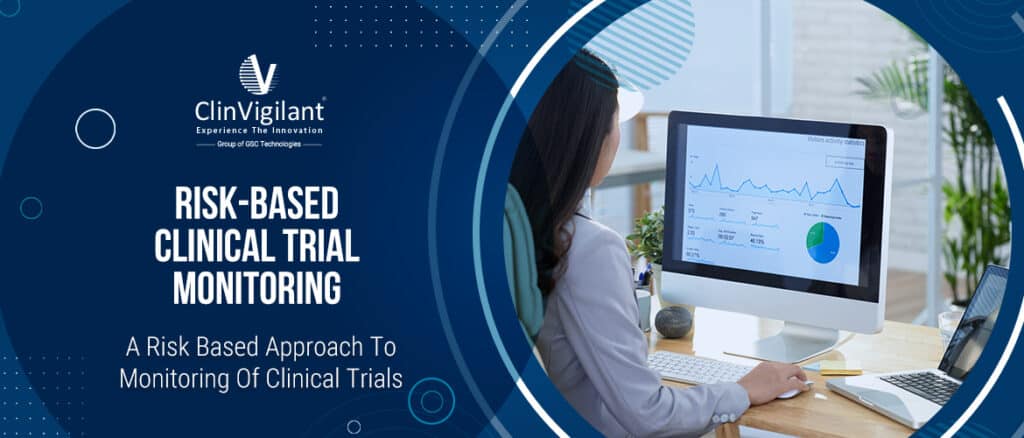- Risk-Based Monitoring Clinical trials
Clinical trials are an essential part of developing new drugs and treatments. Proper monitoring of these trials is crucial to ensure participant safety and data integrity. Traditional monitoring approaches rely heavily on on-site visits and source document verification. However, these methods are incredibly time-consuming and expensive. This has led to a rise in risk-based monitoring techniques that provide more efficient and effective trial oversight. In this blog, we will explore what risk-based monitoring entails, its benefits, and how to implement it.

What is risk-based monitoring?
Risk-based monitoring clinical trials (RBM) involves continuously identifying, analyzing, and mitigating risks throughout a trial. It shifts the focus from routine verification to detecting issues early so they can be addressed quickly. Rather than checking every participant and data point, monitors target higher risk areas. This approach concentrates resources where they are most needed to protect participants and data quality.
Why is there a rise in risk-based monitoring?
Several factors have driven the increase in RBM adoption:
- Reduced costs – By eliminating unnecessary on-site visits and data checks, RBM lowers monitoring costs significantly. This allows sponsors to maximize their budget.
- Remote decentralization – Many trials now utilize telemedicine, mobile apps, and other technologies that allow remote participation. RBM enables oversight of these decentralized trials.
- Large data sets – Larger trials produce substantial data sets that are incredibly labor-intensive to verify fully. RBM allows monitors to focus on high-value data.
- Real-time access – Electronic data capture and centralized databases provide monitors with real-time data access. This enables continuous risk assessment.
- Adaptive trial designs – Trials are becoming more fluid, with changes made based on incoming data. RBM allows monitors to adapt oversight as risks shift.
Click here to learn about Risk-Based Quality Management (RBQM)
Why is risk-based clinical trial monitoring better?
RBM offers several key advantages over traditional monitoring:
- Improved safety – By identifying issues quickly, RBM enables faster intervention when problems arise. This enhances participant safety.
- Increased data quality – Targeted monitoring based on intelligent risk assessments improves overall data integrity.
- Optimized efficiency – Rather than verifying all data, monitors can focus on high-risk areas and adapting as new risks emerge. This saves significant time and resources.
- Real-time insights – Continuous access to data provides instant visibility into trial performance. Issues can be addressed rapidly.
- Reduced costs – Eliminating excessive on-site visits and unnecessary verification offers major budget reductions. Sponsors get more value from their monitoring investment.
- Enhanced flexibility – Remote, decentralized trials require flexible oversight. RBM provides the ability to adapt monitoring strategies as the trial evolves.
The monitoring process
Implementing RBM involves a continuous cycle of risk assessment, targeted monitoring, and response.
Key steps include:
- Identify risks – Examine the protocol, experience from similar trials, site capabilities, and other factors to identify potential risks. These may relate to safety, data quality, site performance, or protocol compliance.
- Develop risk indicators – Define metrics to serve as warning signs for the risks identified. These may include missed visits, Kulder scores, query rates, and other red flags.
- Assess risk levels – Categorize risks as low, medium or high to guide monitoring intensity and focus. High risks warrant greater attention.
- Create risk dashboard – Construct a centralized dashboard to track risk indicators in real-time as data is collected. This provides instant visibility.
- Conduct targeted monitoring – Use centralized data to analyze indicators, focusing on higher risk areas. Verify source data only for concerning findings.
- Adapt approach – Continuously assess emerging risks based on new data or protocol changes. Modify monitoring strategies to address shifting priorities.
- Mitigate risks – When issues arise, implement corrective actions immediately according to the risk level. This may require contacting sites for clarification or intervention.
- Provide feedback – Use monitoring insights to provide proactive feedback to sites and sponsors. This enhances continuous improvement.
The risk dashboard
A risk dashboard is essential for effective RBM. This centralized hub analyzes metrics in real-time to flag potential issues. Key features include:
- Automatic indicator tracking – The system continuously calculates and displays monitor-defined metrics that signal emerging risks. This removes manual data processing.
- Flexible risk scoring – Indicators are scored according to their risk level. As risks evolve, scoring configurations can be adjusted.
- Filtering and prioritization – Monitors can filter by site, patient, or indicator to spotlight high-risk areas. Sorting and color-coding further enhances prioritization.
- Historical views – The dashboard retains indicator data over the trial’s entirety to identify trends and shifts.
- Annotation capabilities – Monitors can add notes to explain certain findings, prescribe corrective actions, or highlight insights.
- Automated notifications – Alerts are triggered when defined risk thresholds are breached, prompting intervention.
- Visual data displays – Charts, graphs, and heat maps provide clear visual representation of complex indicator data.
- Access control – User permissions allow relevant team members to access necessary data while restricting protected information.
- Custom reporting – Ad hoc reports quickly collate relevant data to provide sponsors with monitoring updates.
How to start risk-based clinical trial monitoring?
Implementing effective RBM requires careful planning and preparation:
- Assemble a central monitoring team – Dedicated specialists are needed to design the strategy, continuously assess emerging risks, and take corrective actions.
- Educate all stakeholders – Take time to explain the RBM approach to sites, CRAs, sponsors, regulators, and all involved parties. Clarify roles and responsibilities.
- Examine previous trial data – Evaluate past study metrics to identify areas typically associated with higher risks. Use this data to inform initial priorities.
- Construct a risk library – Compile a catalog of all risks identified from previous trials, literature review, and team insights. Continuously expand this repository as the RBM program matures.
- Develop risk assessment techniques – Create protocols for regularly identifying new risks, scoring indicator metrics, determining focus areas, and adapting the approach. Employ risk assessment models, algorithms, and tools as helpful resources.
- Select and configure software – Ensure monitoring systems can support real-time data access, automated indicator tracking, dashboard creation, notifications and reporting. Integrate with other platforms as needed.
- Pilot the program – Run an initial trial study under the risk-based approach. Evaluate its performance to pinpoint areas for improvement before scaling.
Why a risk-based monitoring toolbox?
While the risk dashboard provides central oversight, monitors need various tools to perform targeted verification efficiently:
- Statistical analysis – Programs like SAS and R offer extensive analytics to uncover patterns and trends. This helps identify data anomalies and site irregularities.
- Data visualization – Tools like Tableau allow risk indicator data to be structured visually for easy identification of issues. Graphs and charts spotlight outliers.
- Sample size calculators – To verify source data for a concerning metric, these tools determine optimal sample sizes to gain statistically significant insights efficiently.
- Query handling – Systems can automate query generation, distribution, and tracking. They also analyze query metrics themselves as risk indicators.
- Centralized document exchange – Secure portals allow easy transfer of source documents from sites to monitors for remote monitoring in clinical trials source data verification.
- Automated reporting – Report generators can quickly summarize monitoring activities, findings and recommended actions for sites and sponsors.
Risk-adapted monitoring tools
RBM requires adaptable tools that can be tailored to mirror the study’s evolving risk levels:
- Remote SDV – For low-risk data, remote SDV of PDF source documents may suffice for verification.
- Centralized EDC dashboard review – Medium-risk indicators can be easily assessed via data dashboards rather than full SDV.
- Targeted on-site SDV – For high-risk data, targeted on-site verification of source documents may be warranted.
- Expanded CRA involvement – CRAs can expand source data review for emerging site risks under monitor guidance.
- Daily alert checks – New safety risks may warrant assigning monitors to check dashboard alerts daily.
- Trigger-based site notification – Threshold breaches for certain metrics can be configured to trigger automated site notification.
- Interactive site dashboards – Sites themselves can access interactive dashboards to monitor their own metrics.
- Expanded site training – High protocol violation rates may necessitate additional site training sessions.
Conclusion
Risk-based monitoring offers a targeted, efficient approach to maximizing virtual clinical monitoring trial oversight. By leveraging centralized data, risk analytics and real-time dashboards, monitors can focus their efforts on critical areas to enhance quality and safety. RBM provides a scalable solution as trials and data sets grow increasingly complex. With careful implementation, sponsors can optimize limited monitoring resources to drive continuous improvement through rapid issue mitigation. This evolves monitoring from reactive to proactive while boosting productivity.
FAQs
What is risk-based monitoring in clinical trials?
Risk-based monitoring (RBM) is an approach to clinical trial oversight that focuses monitoring clinical trials activities on the areas of greatest risk to data quality and patient safety. It involves:
- Identifying critical data points and processes that are most important for trial quality and integrity based on an initial risk assessment
- Continuously evaluating risks throughout the trial and adjusting monitoring activities accordingly
- Using a mix of centralized statistical monitoring, targeted on-site visits, and remote clinical monitoring data reviews to detect issues proactively
Looking for support in your clinical trial? Click here to connect with us or fill out the form below
How does RBM differ from traditional monitoring approaches?
Traditional monitoring relies heavily on 100% source data verification (SDV) and on-site monitoring visits. RBM moves away from routine visits and full SDV towards more centralized and targeted oversight driven by data analytics. This allows for more efficient use of monitoring resources.
What are some key benefits of implementing RBM?
- Improves patient safety by enabling earlier detection of issues
- Reduces monitoring costs by eliminating unnecessary activities
- Increases data quality through continuous risk review
- Allows for more flexible, remote monitoring during disruptions like COVID-19
- Focuses sponsor oversight on critical data and processes
RBM aligns with regulator guidance and can maintain quality while enhancing trial efficiency. Careful planning and change management is key for successful implementation.
Need support for your clinical trial?
Do you have any questions about Risk-Based Monitoring In Clinical Trials? Or Do you need any expertise support for your clinical trials? Fill out the form below to connect with our experts.

